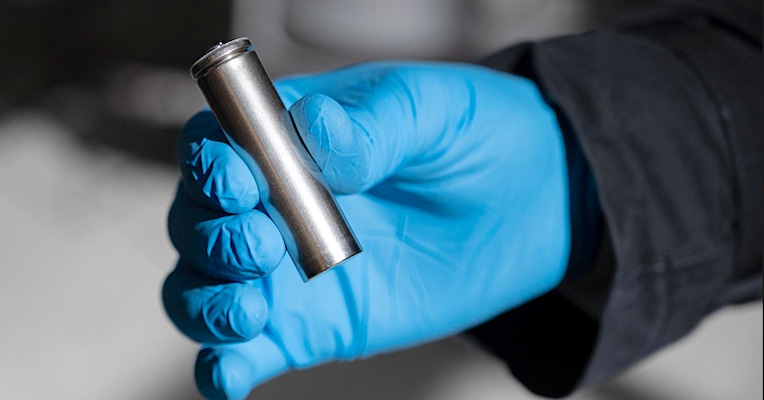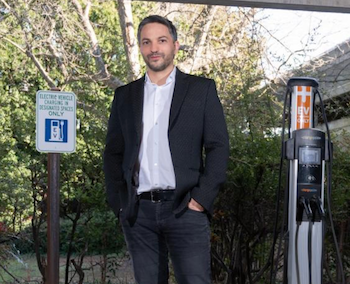Lithium-ion batteries can be manufactured using a low-melting-point solid electrolyte that infiltrates battery electrodes.
March 12, 2021

Present-day commercial lithium-ion batteries—the kind used for cell phones, laptops, electric vehicles (EV), and renewable energy grid storage—use a liquid electrolyte based upon organic solvents. The electrolyte allows the flow of lithium ions between the anode (negative electrode) and the cathode (positive electrode) while the battery is charging and discharging. But these organic solvents are highly flammable and provide a ready fuel source for a fire if the battery should short out or overheat.
Solid State Safer
To make safer, more fire-resistant batteries, solid electrolytes, made from polymers of ceramic materials are under study. We usually think of solid electrolytes for batteries with an anode made from metallic lithium, rather than the carbon graphite that conventional lithium-ion batteries employ. There, the use of a solid-state electrolyte can suppress the formation of needle-like crystals of lithium, called dendrites, that can form on the surface of the lithium metal anode while charging. There are however applications where a solid electrolyte can be used to enhance the performance and safety of lithium-ion batteries that use traditional anodes and cathodes.
This Is New
That is the basis of research by Georgia Tech and described in a news release. A new melt-infiltration fabrication technique under examination at the University could allow solid-state automotive lithium-ion batteries to use non-flammable ceramic electrolytes using the same production processes and equipment as is used with batteries made using conventional liquid electrolytes.
The melt-infiltration technology uses electrolyte materials that can be infiltrated into porous yet densely packed, thermally stable electrodes. This process can be done in a single-step and produces high-density composites that, according to the news release, are created via a “…pressure-less, capillary-driven infiltration of a molten solid electrolyte into porous bodies, including multilayered electrode-separator stacks.”
“While the melting point of traditional solid-state electrolytes can range from 700 degrees Celsius to over 1,000 degrees Celsius, we operate at a much lower temperature range, depending on the electrolyte composition, roughly from 200 to 300 degrees Celsius,” explained Gleb Yushin, a professor in the School of Materials Science and Engineering at Georgia Tech. “At these lower temperatures, fabrication is much faster and easier. Materials at low temperatures don’t react. The standard electrode assemblies, including the polymer binder or glue, can be stable in these conditions.”
The manufacturing technology is similar to that used in the fabrication of lithium-ion cells with liquid electrolytes but uses a solid electrolyte with a low melting point that can melt and infiltrate into the electrodes during the manufacturing process. The research team reports that multi-layered cells of any size or shape can be manufactured and that the molten electrolyte can infiltrate anode and cathode materials as well as separators within the cell.
|
Georgia Tech professor Gleb Yushin, at a campus EV charging station, sees melt-infiltration technology opening the floodgates to more lithium-ion battery innovation. |
Compatible
The Georgia Tech team is encouraged by the potential of this manufacturing process to enable battery makers to produce lighter, safer, and more energy-dense batteries. “The developed melt-infiltration technology is compatible with a broad range of material chemistries, including so-called conversion-type electrodes. Such materials have been demonstrated to increase automotive cell energy density by over 20% now and by more than 100% in the future,” said Georgia Tech research scientist Kostiantyn Turcheniuk.
“Melt-infiltration technology is the key advance. The cycle life and stability of Li-ion batteries depend strongly on the operating conditions, particularly temperature,” Georgia Tech graduate student Yiran Xiao explained. “If batteries are overheated for a prolonged period, they commonly begin to degrade prematurely, and overheated batteries may catch on fire. That has prompted nearly all-electric vehicles (EV) to include sophisticated and rather expensive cooling systems.” Solid-state batteries like those described in the research may only require heaters—significantly less expensive than battery cooling systems.
Next Steps
The technique is not yet commercially ready, but Yushin predicts that if a significant portion of the future EV market embraces solid-state batteries, “This would probably be the only way to go,” since it will allow manufacturers to use their existing production facilities and infrastructure. “That’s why we focused on this project – it was one of the most commercially viable areas of innovation for our lab to pursue,” he said.
The Materials Science team is focused on developing other electrolytes with lower melting points and higher conductivities using the same techniques that have been proven in the lab. “So many incredibly smart scientists are focused on solving very challenging scientific problems, while completely ignoring economic and technical practicality. They are studying and optimizing very high-temperature electrolytes that are not only dramatically more expensive to use in cells but are also up to five times heavier compared with liquid electrolytes,” Yushin explained. “My goal is to push the research community to look outside that chemical box.”
Kevin Clemens is a Senior Editor with Battery Technology.
About the Author(s)
You May Also Like






